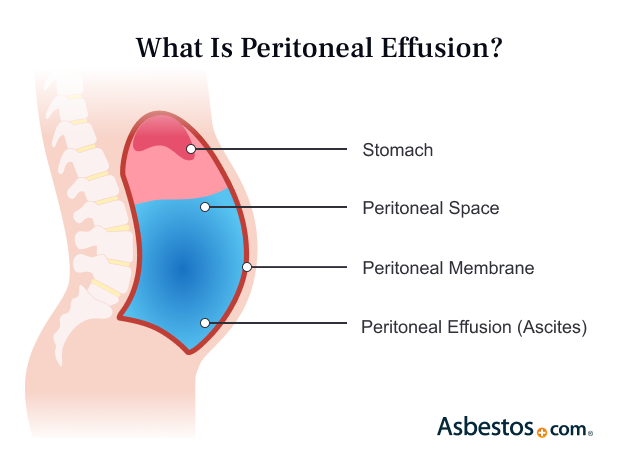“As a young woman with abdominal pain, I had a really hard time convincing someone I was in pain. A really hard time. I was told it was just my period,” Jayda said. Her doctors finally did a laparoscopy. Her peritoneal effusion turned out to be more than a gallon of fluid and the surgeon saw growths on her peritoneum. A biopsy confirmed her peritoneal mesothelioma diagnosis.
Ascites
Ascites, or peritoneal effusion, is a buildup of excess fluid in the abdomen. Cirrhosis, liver diseases, peritoneal mesothelioma or other conditions can cause fluid to build up. Doctors may use chemotherapy or drain the fluid to treat this fluid accumulation.

What Is Ascites?
Ascites is a buildup of fluid in your peritoneal cavity (space in your belly containing your digestive organs). When fluid accumulates in this space, it can cause your belly to swell. Ascites is common in people with peritoneal mesothelioma and liver issues.
The peritoneum is a thin membrane that lines the inside of your abdominal cavity. Conditions such as cirrhosis or cancers, like peritoneal mesothelioma, can cause fluid to cross the peritoneum. When this happens, the fluid then collects in your peritoneal cavity, and you can notice swelling and other symptoms.
Key Facts About Abdominal Ascites
- Cirrhosis is the most common cause of ascites. It accounts for 80% of cases.
- Cancer is the second most common cause of ascites, with about 10% of cases.
- Infections can also cause ascites.
- Recent research evaluating the treatment of ascites in people with malignant mesothelioma show promising results with chemotherapy.
Protein levels in your abdominal fluid are measured and used to help classify ascites or peritoneal effusions. An exudate is peritoneal fluid with a high protein level. A transudate is peritoneal fluid with a low protein level. This can help doctors find the cause of your peritoneal effusion. Cirrhosis, or liver disease, usually causes low protein levels. Cancer and infections usually cause high levels.
Learn about your diagnosis, top doctors and how to pay for treatment in our free mesothelioma guide.
Get Your GuideWhat Causes Peritoneal Effusions?
Cirrhosis, or scarring of the liver, is the most common cause of ascites. Cirrhosis can cause high pressure in your liver’s veins. This can force fluid into your abdominal cavity.
Cancer, such as peritoneal mesothelioma, is the second most common cause of peritoneal effusions. Cancer cells can irritate your abdominal lining. This can cause excess fluid to build up. Peritoneal mesothelioma tumors, for example, can also cause the membrane to leak fluid. As the mesothelioma spreads, covering more of the peritoneal surface, ascites often worsens.
Causes of Peritoneal Effusions and Percentage of Cases
- Cirrhosis or liver disease (about 81%)
- Cancer (about 10%)
- Heart failure (about 3%)
- Other causes (about 2%)
- Tuberculosis (about 2%)
- Dialysis (about 1%)
- Pancreatic disorder (about 1%)
Infections can also cause pleural effusions. Peritonitis is a nonspecific term for irritation of the abdominal lining. Any cause of peritonitis can cause fluid to build up. Tuberculosis and pancreatitis, for example, are causes. Bacterial infections, from conditions like a perforated ulcer or perforated appendicitis can also cause ascites to develop. Irritation of the peritoneum tends to be painful.
Heart or kidney failure can also cause ascites. When there’s less blood flow to your kidneys, sometimes because your heart isn’t pumping with enough force, your kidneys will respond, reducing urine output, and fluid retention can happen. Heart failure can also affect your liver, causing the pressure in the liver veins to increase. This can lead to the development of ascites.
Symptoms of Peritoneal Effusion
The most common symptom of ascites is discomfort. As abdominal fluid develops, people can feel bloated or full. Some people also report feeling nausea and losing appetite. Symptoms can vary depending on the severity of the ascites and its cause. As the ascites worsens, pain and physical limitations can develop.
Symptoms of Abdominal Ascites
- Abdominal pain
- Abdominal swelling or distention
- Chest pain
- Fatigue
- Loss of appetite
- Nausea
- Swollen ankles
- Trouble breathing
- Weight gain
Ascites is always a sign of a problem. It’s one of many signs and symptoms of mesothelioma. It occurs in more than 50% of peritoneal mesothelioma cases. It can also occur when other types of mesothelioma spread to the abdomen.
Dr. Anton Strocel, an OB/GYN who treated Trina Reif, spoke to us about her case. Trina is a 20-year peritoneal survivor. Dr. Strocel said, “Trina had unexplained ascites. We did an exploratory laparotomy. We also did multiple peritoneal biopsies. She had an angry looking peritoneum. Her diagnosis was abdominal mesothelioma.”

“After reading the guide, I felt more confident about what was ahead.” – Carla F., mesothelioma survivor
Get Your Free GuideHow Is Peritoneal Effusion Diagnosed?
Doctors use a mix of tests to diagnose ascites. A physical exam and imaging scans are performed. Tests such as ultrasound and CT scans can show excess fluid in your abdominal space. A doctor will likely think of ascites if there is severe abdominal swelling.
If fluid is present, doctors need to collect a sample of the fluid (a liquid biopsy). The key to a diagnosis is the laboratory analysis of your peritoneal fluid. The fluid is often collected during a procedure known as a paracentesis. This procedure places a needle into your abdominal fluid to drain and collect it for analysis.
The sample is analyzed in a pathology lab. The type of ascites you have is determined. Pathologists look for potential cancer cells. This process is known as cytology.
A 2022 study in the journal Cytopathology looked at cytology testing of ascites fluid. It was able to detect malignant mesothelioma about 34% of the time. This underscores why doctors rely on tissue biopsies most of the time for the diagnosis of peritoneal mesothelioma.
Treating Ascites
Treatments for abdominal ascites depend on its cause. Treatments for cancer-related ascites typically involve a combination of fluid drainage, chemo, surgical procedures and possibly emerging therapies. These approaches aim to relieve symptoms while controlling the underlying condition. A multidisciplinary approach, involving input from medical doctors, surgeons and oncologists is warranted to evaluate and treat abdominal ascites.
Treatment Options for Peritoneal Effusions
- Chemo: Powerful drugs kill the cancer cells causing fluid buildup, reducing malignant ascites and controlling disease progression.
- Intraperitoneal catheter: A surgically placed tube enables ongoing fluid drainage without repeated needle procedures to relieve symptoms in severe, recurrent cases.
- Paracentesis: A minimally invasive procedure drains fluid with a needle to alleviate symptoms.
- PIPAC: Pressurized intraperitoneal aerosol chemo is an emerging therapy delivering chemo as a pressurized aerosol directly into the belly.
- Tumor-removing surgery and HIPEC: Cytoreductive surgery removes visible tumors and directly applied and circulated heated intraperitoneal chemo kills remaining cancer and effectively controls malignant ascites.
Important in mesothelioma treatment, customizing treatment for each person with ascites supports better symptom management and improves quality of life. Abdominal ascites results from benign or malignant diseases. Management varies accordingly, focusing on symptom relief in benign cases and combining multiple treatments when cancer like mesothelioma is involved.
Ongoing clinical studies continue to enhance treatment strategies. For instance, a 2023 study in the Journal of Surgical Oncology found combining fluid drainage with chemo and nutritional support provides superior patient outcomes.
Common Questions About Peritoneal Effusions
- Can abdominal ascites be prevented?
-
Some measures can reduce the risk of liver disease and certain cancers, but they can’t guarantee prevention. Adopting a healthy lifestyle may lower the chance of developing cirrhosis. Key steps include avoiding alcohol and tobacco use, maintaining regular exercise and following a balanced diet. Reducing salt intake can also help limit fluid retention in the body.
- What are the complications associated with abdominal ascites?
-
Ascites can exert pressure on abdominal organs and the chest, causing discomfort. Persistent fluid accumulation increases the risk of infection, such as spontaneous bacterial peritonitis. Additional complications may include abdominal hernias, abdominal pain, difficulty breathing, fluid buildup in the lungs and a heightened risk of further infections. Loss of appetite can lead to nutritional issues.
- Are there any risk factors for developing abdominal ascites?
-
Several factors increase the likelihood of developing ascites. These include: abdominal infections, abdominal or pelvic cancers, alcohol abuse, congestive heart failure, genetic liver diseases, hepatitis B or C and nonalcoholic fatty liver disease.
Conditions that lead to cirrhosis represent the most significant risk. Certain cancers and infections markedly raise the risk as well. Heart or kidney failure can also contribute to fluid accumulation in the abdomen.
- Can peritoneal effusions recur?
-
Peritoneal effusions often recur after treatment, depending on their cause. Fluid buildup may return within days or months. In malignant ascites, recurrent ascites can indicate advancing cancer. Persistent or recurrent ascites may be a sign of cancers such as mesothelioma. In such cases, seeking a second medical opinion and consulting a mesothelioma specialist can be beneficial.



